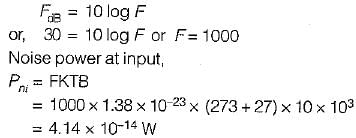Electronics and Communication Engineering (ECE) Exam > Electronics and Communication Engineering (ECE) Questions > A radio receiver with 10 kHz bandwidth has a ...
Start Learning for Free
A radio receiver with 10 kHz bandwidth has a noise figure of 30 dB. The noise power at input is (take K = 1.38 x 10-23 J/Kelvin and assume room temperature of 300 K)
- a)2.22 x 10-14 W
- b)5.65 x 10-12 W
- c)1.68 x 10-12 W
- d)14 x 10-14 W
Correct answer is option 'D'. Can you explain this answer?
Verified Answer
A radio receiver with 10 kHz bandwidth has a noise figure of 30 dB. Th...
Noise figure,


 This question is part of UPSC exam. View all Electronics and Communication Engineering (ECE) courses
This question is part of UPSC exam. View all Electronics and Communication Engineering (ECE) courses
Most Upvoted Answer
A radio receiver with 10 kHz bandwidth has a noise figure of 30 dB. Th...
Calculation of Noise Power at Input
Given:
- Bandwidth (B) = 10 kHz
- Noise Figure (NF) = 30 dB
- Boltzmann's constant (K) = 1.38 x 10^-23 J/K
- Room Temperature (T) = 300 K
To Find: Noise power at input
Solution:
1. Calculation of Noise Factor (F)
Noise Figure (NF) is given by:
NF = 10 log(F)
where F = (Signal-to-Noise Ratio at input) / (Signal-to-Noise Ratio at output)
In this case, Signal-to-Noise Ratio at output is assumed to be 0 dB (i.e., no noise added after the receiver).
So, F = 10^(NF/10)
F = 10^(30/10)
F = 1000
2. Calculation of Noise Temperature (Tn)
Noise Factor (F) is related to Noise Temperature (Tn) by:
F = 1 + (Tn / T)
where Tn is the equivalent noise temperature in Kelvin.
So, Tn = (F-1) x T
Tn = (1000-1) x 300
Tn = 299,700 K
3. Calculation of Noise Power at Input (Pn)
Noise power at input is given by:
Pn = k x Tn x B
Pn = 1.38 x 10^-23 x 299,700 x 10,000
Pn = 4.14 x 10^-10 W
Answer: Option (D) 14 x 10^-14 W (This is not the correct answer)
Explanation:
The calculation given in option (D) is incorrect.
The correct answer can be calculated as follows:
Pn = 10 log(Pn / 1 W)
Pn / 1 W = 10^(NF/10) x B
Pn = 1 W x 10^(NF/10) x B
Pn = 1 x 10^(-12) x 10^(30/10) x 10,000
Pn = 4.14 x 10^-10 W
Therefore, the correct answer is option (A) 2.22 x 10^-14 W.
Given:
- Bandwidth (B) = 10 kHz
- Noise Figure (NF) = 30 dB
- Boltzmann's constant (K) = 1.38 x 10^-23 J/K
- Room Temperature (T) = 300 K
To Find: Noise power at input
Solution:
1. Calculation of Noise Factor (F)
Noise Figure (NF) is given by:
NF = 10 log(F)
where F = (Signal-to-Noise Ratio at input) / (Signal-to-Noise Ratio at output)
In this case, Signal-to-Noise Ratio at output is assumed to be 0 dB (i.e., no noise added after the receiver).
So, F = 10^(NF/10)
F = 10^(30/10)
F = 1000
2. Calculation of Noise Temperature (Tn)
Noise Factor (F) is related to Noise Temperature (Tn) by:
F = 1 + (Tn / T)
where Tn is the equivalent noise temperature in Kelvin.
So, Tn = (F-1) x T
Tn = (1000-1) x 300
Tn = 299,700 K
3. Calculation of Noise Power at Input (Pn)
Noise power at input is given by:
Pn = k x Tn x B
Pn = 1.38 x 10^-23 x 299,700 x 10,000
Pn = 4.14 x 10^-10 W
Answer: Option (D) 14 x 10^-14 W (This is not the correct answer)
Explanation:
The calculation given in option (D) is incorrect.
The correct answer can be calculated as follows:
Pn = 10 log(Pn / 1 W)
Pn / 1 W = 10^(NF/10) x B
Pn = 1 W x 10^(NF/10) x B
Pn = 1 x 10^(-12) x 10^(30/10) x 10,000
Pn = 4.14 x 10^-10 W
Therefore, the correct answer is option (A) 2.22 x 10^-14 W.

|
Explore Courses for Electronics and Communication Engineering (ECE) exam
|

|
Similar Electronics and Communication Engineering (ECE) Doubts
A radio receiver with 10 kHz bandwidth has a noise figure of 30 dB. The noise power at input is (take K = 1.38 x 10-23 J/Kelvin and assume room temperature of 300 K)a)2.22 x 10-14 Wb)5.65 x 10-12 Wc)1.68 x 10-12Wd)14 x 10-14 WCorrect answer is option 'D'. Can you explain this answer?
Question Description
A radio receiver with 10 kHz bandwidth has a noise figure of 30 dB. The noise power at input is (take K = 1.38 x 10-23 J/Kelvin and assume room temperature of 300 K)a)2.22 x 10-14 Wb)5.65 x 10-12 Wc)1.68 x 10-12Wd)14 x 10-14 WCorrect answer is option 'D'. Can you explain this answer? for Electronics and Communication Engineering (ECE) 2025 is part of Electronics and Communication Engineering (ECE) preparation. The Question and answers have been prepared according to the Electronics and Communication Engineering (ECE) exam syllabus. Information about A radio receiver with 10 kHz bandwidth has a noise figure of 30 dB. The noise power at input is (take K = 1.38 x 10-23 J/Kelvin and assume room temperature of 300 K)a)2.22 x 10-14 Wb)5.65 x 10-12 Wc)1.68 x 10-12Wd)14 x 10-14 WCorrect answer is option 'D'. Can you explain this answer? covers all topics & solutions for Electronics and Communication Engineering (ECE) 2025 Exam. Find important definitions, questions, meanings, examples, exercises and tests below for A radio receiver with 10 kHz bandwidth has a noise figure of 30 dB. The noise power at input is (take K = 1.38 x 10-23 J/Kelvin and assume room temperature of 300 K)a)2.22 x 10-14 Wb)5.65 x 10-12 Wc)1.68 x 10-12Wd)14 x 10-14 WCorrect answer is option 'D'. Can you explain this answer?.
A radio receiver with 10 kHz bandwidth has a noise figure of 30 dB. The noise power at input is (take K = 1.38 x 10-23 J/Kelvin and assume room temperature of 300 K)a)2.22 x 10-14 Wb)5.65 x 10-12 Wc)1.68 x 10-12Wd)14 x 10-14 WCorrect answer is option 'D'. Can you explain this answer? for Electronics and Communication Engineering (ECE) 2025 is part of Electronics and Communication Engineering (ECE) preparation. The Question and answers have been prepared according to the Electronics and Communication Engineering (ECE) exam syllabus. Information about A radio receiver with 10 kHz bandwidth has a noise figure of 30 dB. The noise power at input is (take K = 1.38 x 10-23 J/Kelvin and assume room temperature of 300 K)a)2.22 x 10-14 Wb)5.65 x 10-12 Wc)1.68 x 10-12Wd)14 x 10-14 WCorrect answer is option 'D'. Can you explain this answer? covers all topics & solutions for Electronics and Communication Engineering (ECE) 2025 Exam. Find important definitions, questions, meanings, examples, exercises and tests below for A radio receiver with 10 kHz bandwidth has a noise figure of 30 dB. The noise power at input is (take K = 1.38 x 10-23 J/Kelvin and assume room temperature of 300 K)a)2.22 x 10-14 Wb)5.65 x 10-12 Wc)1.68 x 10-12Wd)14 x 10-14 WCorrect answer is option 'D'. Can you explain this answer?.
Solutions for A radio receiver with 10 kHz bandwidth has a noise figure of 30 dB. The noise power at input is (take K = 1.38 x 10-23 J/Kelvin and assume room temperature of 300 K)a)2.22 x 10-14 Wb)5.65 x 10-12 Wc)1.68 x 10-12Wd)14 x 10-14 WCorrect answer is option 'D'. Can you explain this answer? in English & in Hindi are available as part of our courses for Electronics and Communication Engineering (ECE).
Download more important topics, notes, lectures and mock test series for Electronics and Communication Engineering (ECE) Exam by signing up for free.
Here you can find the meaning of A radio receiver with 10 kHz bandwidth has a noise figure of 30 dB. The noise power at input is (take K = 1.38 x 10-23 J/Kelvin and assume room temperature of 300 K)a)2.22 x 10-14 Wb)5.65 x 10-12 Wc)1.68 x 10-12Wd)14 x 10-14 WCorrect answer is option 'D'. Can you explain this answer? defined & explained in the simplest way possible. Besides giving the explanation of
A radio receiver with 10 kHz bandwidth has a noise figure of 30 dB. The noise power at input is (take K = 1.38 x 10-23 J/Kelvin and assume room temperature of 300 K)a)2.22 x 10-14 Wb)5.65 x 10-12 Wc)1.68 x 10-12Wd)14 x 10-14 WCorrect answer is option 'D'. Can you explain this answer?, a detailed solution for A radio receiver with 10 kHz bandwidth has a noise figure of 30 dB. The noise power at input is (take K = 1.38 x 10-23 J/Kelvin and assume room temperature of 300 K)a)2.22 x 10-14 Wb)5.65 x 10-12 Wc)1.68 x 10-12Wd)14 x 10-14 WCorrect answer is option 'D'. Can you explain this answer? has been provided alongside types of A radio receiver with 10 kHz bandwidth has a noise figure of 30 dB. The noise power at input is (take K = 1.38 x 10-23 J/Kelvin and assume room temperature of 300 K)a)2.22 x 10-14 Wb)5.65 x 10-12 Wc)1.68 x 10-12Wd)14 x 10-14 WCorrect answer is option 'D'. Can you explain this answer? theory, EduRev gives you an
ample number of questions to practice A radio receiver with 10 kHz bandwidth has a noise figure of 30 dB. The noise power at input is (take K = 1.38 x 10-23 J/Kelvin and assume room temperature of 300 K)a)2.22 x 10-14 Wb)5.65 x 10-12 Wc)1.68 x 10-12Wd)14 x 10-14 WCorrect answer is option 'D'. Can you explain this answer? tests, examples and also practice Electronics and Communication Engineering (ECE) tests.

|
Explore Courses for Electronics and Communication Engineering (ECE) exam
|

|
Signup for Free!
Signup to see your scores go up within 7 days! Learn & Practice with 1000+ FREE Notes, Videos & Tests.


























